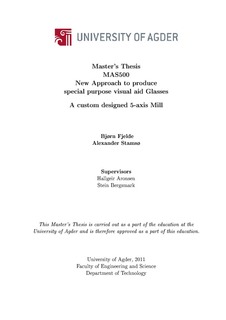New approach to produce special purpose visual aid glasses : a custom designed 5-axis mill
Master thesis
Permanent lenke
http://hdl.handle.net/11250/136692Utgivelsesdato
2011Metadata
Vis full innførselSamlinger
Sammendrag
The thesis problem formulation is given by the company ProVista. ProVistas area of expertise is mainly
the rehabilitation of visually impaired. This includes research, training of opticians and sale of supporting
materials such as glasses with magni cation. The thesis problem is a part of the research to give their
customers a better product with much shorter delivery time. Today the customers normally have to wait
several weeks to get their visual aid glasses. The reason for this is that the holes are milled manually. With
CNC mills existing some decades now, the visual aid community should also bene t from the advantage of
CNC milling. Both producer and customers will bene t from a new automated small ve axis mill, especially
ProVista that has started this paradigm shift. ProVista wants the opportunity to mill holes in their own
glasses. Today they are depending on two foreign companies to mill the holes. This is both time consuming
and costly for ProVista and their customers.
This master thesis comprises the study, design and manufacturing of a ve axis mill. The decision to
build a ve axis CNC mill was made early in the process, this was done by integrating a three axis CNC
mill with two extra rotations axes. The project incorporates the main areas within mechatronics such as
designing and building mechanical and electronic parts and the interplay between them, control system for
controlling and tuning the motors. The mill shall produce di erent holes, mostly circular with angles so that
the binoculars achieve the correct focal point in accordance to the user's needs. The users are mainly surgeons
and dentists, who depend on magni cation provided with two binoculars, focused at an item to performer
their work more e ciently and correctly. In ProVista sub market the users vary from hobbyist using binocular
glasses to paint tin soldiers, old people reading the paper and other people that are visually impaired.
The solution this project presents is a new small ve axis CNC mill special designed for milling in glasses.
The mill is based on the High-Z S400 purchased from CNC-Step in Germany. The chosen design for the two
extra axes is a two axis rotary table design also known as trunnion. The trunnion table was tted with two
stepper motor, from the same producer used on the High-Z S400. The stepper motors were chosen mainly
for their low cost and ease of use. There has been made a control box with motor drives and power supply
for the trunnion table. The control box is also tted with serial ports, parallel port, fan, emergency button,
fuse and power connection. A new xture for glasses is also designed and built. This will most probably be
the rst milling xture for a pair of glasses in the world.
The software used in the project is Excel and Mach3. Excel was used to generate the G code from the
position, diameter and the angle of the holes. After this the data is saved in a txt le, making it readable
by Mach3. This process has been made as user friendly as possible so that a user can operate the milling
machine without problems. The Mach3 CNC program already has a good enough interface, and only needed
to be modi ed with a six axes interface. The Excel spreadsheet is been made simpler and the user may only
change a few variables, the transfer of the G code is also been done simpler by adding the possibility to save
the column with G code as txt le. The most typical holes that ProVista needs are circular holes and oblong
holes (prism).
After implementation several test were carried out to verify that the di erent parts obtained the requirements.
Among the tests that were carried out was: resolution and repeatability for the mill, and the
backlash for the trunnion table. In the last test it was milled holes through glasses to verify that the nal
product met the requirements
All tests met the requirements with good margin, except the last test. The problem will be xed and
the test will be redone before handing over the machine to ProVista.
With the new automated mill ProVista will be able to o er high quality visual aids on the world market.
Their products will be made quicker and at a lower cost, bene ting both ProVista and the customers.
ProVista will also have a new tool in their further research, which may result in new methods to help visually
impaired so they may have a better quality of life. With the newly acquired high capacity to mill holes in
glasses, ProVista would be able to take in orders from other visual aid companies.
Further work may involve reducing the size of the mill since a large portion of the work area is unused. The user interface should be something similar to HMI (Human Machine Interface) where the users do not
see the Mach3 or Excel and just put in the desired position, diameter and angles on a touch screen. The
xture should also be modi ed so that the glasses are self centred, this will reduce any minor errors. A new
spindle should also be re tted to reduce noise level.
Beskrivelse
Masteroppgave i mekatronikk MAS500 2011 – Universitetet i Agder, Grimstad
